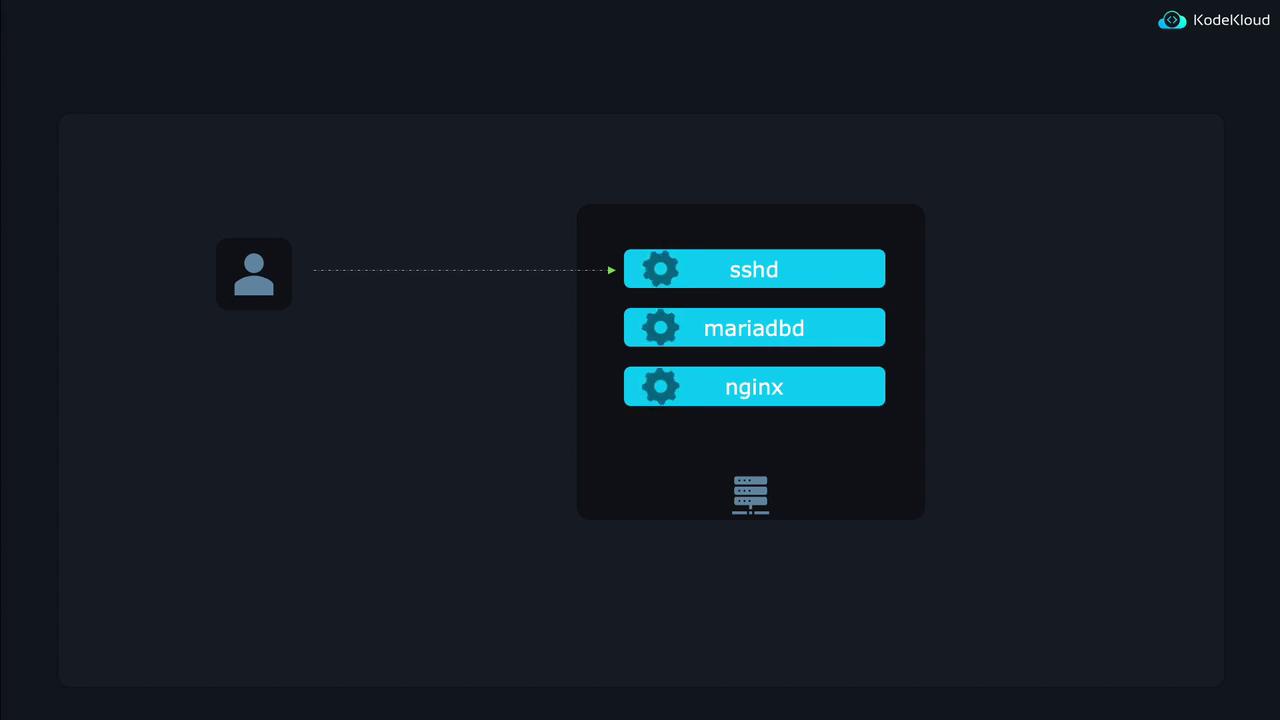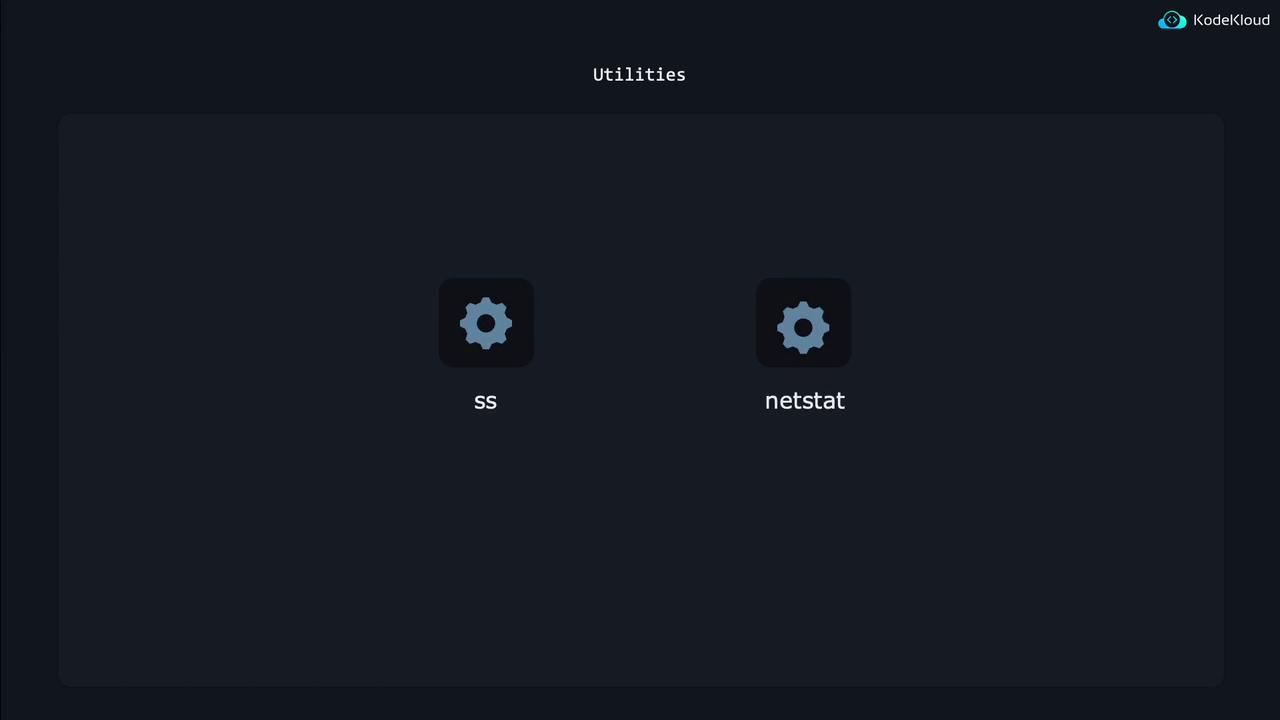Linux Foundation Certified System Administrator (LFCS)
Networking
Start Stop and Check Status of Network Services
In this guide, we explore how to manage network services in Linux by starting, stopping, and checking their status. Many servers run multiple services—such as the SSH daemon—that listen for incoming network connections. The SSH daemon, for example, runs in the background, enabling remote login capabilities.
Let's begin by examining the programs currently active and waiting for incoming network connections.

Viewing Active Network Connections
Two commonly used utilities for viewing active network connections are SS and Netstat. While SS is the modern alternative, Netstat is older and may eventually be deprecated in future Linux releases.

Using the SS Utility
To list all programs that are ready to accept incoming connections, issue the following command:
sudo ss -ltunp
This command provides output similar to the partial example below. In later sections, we will examine a complete output listing all the fields.
$ sudo ss -ltunp
Netid State Recv-Q Send-Q Local Address:Port
tcp LISTEN 0 128 0.0.0.0:22
Below is a brief overview of the options used:
- -l: Only display sockets currently listening for connections.
- -t: Filter to show only TCP connections.
- -u: Include UDP connections.
- -n: Show numeric values (such as port numbers) instead of resolving service names.
- -p: Display the process using each socket (root privileges are required to view processes owned by root).
Tip
Using the -n option ensures that you see exact port numbers. For example, port 22 in the output confirms the SSH daemon's listening port.
A useful mnemonic to remember these options is L-T-U-N-P (Listening, TCP, UDP, Numeric, Process). Alternatively, arrange them as TUNLP (Tunnel Programs) for ease of recall.
If you are ever uncertain about the available options, check the SS help page:
ss --help
Detailed Analysis of SS Output
Let’s inspect the output in detail, focusing on the local address and port columns:
$ sudo ss -ltunp
Netid State Recv-Q Send-Q Local Address:Port
tcp LISTEN 0 128 0.0.0.0:22
$ sudo ss -tunlp
$ ss --help
Usage: ss [ OPTIONS ]
ss [ OPTIONS ] [ FILTER ]
-h, --help this message
-V, --version output version information
-n, --numeric don't resolve service names
-r, --resolve resolve host names
-a, --all display all sockets
-l, --listening display listening sockets
-e, --options show timer information
-E, --extended show detailed socket information
-m, --memory show socket memory usage
-p, --processes show process using socket
An IP address like 127.0.0.1 in the Local Address column indicates that the service is only accepting connections from the local machine (localhost). For example, a web server (NGINX) connecting to a database server (MariaDB) on the same machine typically uses 127.0.0.1 on port 3306.
Consider the following enhanced SS output:
$ sudo ss -ltunp
Netid State Recv-Q Send-Q Local Address:Port Peer Address:Port Process
tcp LISTEN 0 80 127.0.0.1:3306 0.0.0.0:* users:(("mariadb",pid=738,fd=20))
tcp LISTEN 0 128 0.0.0.0:22 0.0.0.0:* users:(("sshd",pid=679,fd=3))
tcp LISTEN 0 128 [::]:22 [::]:* users:(("sshd",pid=679,fd=4))
In this example:
- MariaDB listens on
127.0.0.1:3306, limiting its access to the localhost. - SSHD listens on both IPv4 (
0.0.0.0:22) and IPv6 ([::]:22), allowing both local and external connections.
Another SS output reiterates these points:
$ sudo ss -ltunp
Netid State Recv-Q Send-Q Local Address:Port Peer Address:Port Process
tcp LISTEN 0 80 127.0.0.1:3306 0.0.0.0:* users:(("mariadb",pid=738,fd=20))
tcp LISTEN 0 128 0.0.0.0:22 0.0.0.0:* users:(("sshd",pid=679,fd=3))
tcp LISTEN 0 128 :::22 :::* users:(("sshd",pid=679,fd=4))
Checking Service Status with systemctl
To verify the status of these network services, you can use the systemctl command as follows:
systemctl status mariadb.service
systemctl status ssh.service
Service Naming Convention
On Ubuntu, the SSH service is often listed as ssh (without a trailing "d"). In contrast, other distributions like Red Hat may refer to it as sshd.
Below is an example of the output for both MariaDB and SSH services:
$ sudo ss -ltunp
Netid State Recv-Q Send-Q Local Address:Port Peer Address:Port Process
tcp LISTEN 0 80 127.0.0.1:3306 0.0.0.0:* users:(("mariadb",pid=738,fd=20))
tcp LISTEN 0 128 0.0.0.0:22 0.0.0.0:* users:(("sshd",pid=679,fd=3))
tcp LISTEN 0 128 [::]:22 [::]:* users:(("sshd",pid=679,fd=4))
$ systemctl status mariadb.service
● mariadb.service - MariaDB 10.6.16 database server
Loaded: loaded (/lib/systemd/system/mariadb.service; enabled; vendor preset: enabled)
Active: active (running) since Mon 2024-04-01 03:28:40 UTC; 16min ago
Docs: man:mariadb(8)
https://mariadb.com/kb/en/library/systemd/
Main PID: 738 (mariadb)
$ systemctl status ssh.service
● ssh.service - OpenBSD Secure Shell server
Loaded: loaded (/lib/systemd/system/ssh.service; enabled; vendor preset: enabled)
Active: active (running) since Mon 2024-04-01 03:28:39 UTC; 17min ago
Docs: man:sshd(8)
man:sshd_config(5)
Main PID: 679 (sshd)
Stopping and Disabling Services
To stop the MariaDB service, use the following command. After you stop it, re-run the SS command to verify that port 3306 no longer appears.
sudo systemctl stop mariadb.service
The SS output after stopping MariaDB might look like this:
$ sudo ss -ltunp
Netid State Recv-Q Send-Q Local Address:Port Peer Address:Port Process
tcp LISTEN 0 128 0.0.0.0:22 0.0.0.0:* users:(("sshd",pid=679,fd=3))
tcp LISTEN 0 128 [::]:22 [::]:* users:(("sshd",pid=679,fd=4))
Prevent MariaDB from starting automatically at boot with:
sudo systemctl disable mariadb.service
You can later re-enable and start the service as needed.
Inspecting Process Details
After confirming the SSH daemon's process ID from the SS output (e.g., PID 679), you can use the ps command to inspect it further:
$ ps 679
PID TTY STAT TIME COMMAND
679 ? Ss 0:00 sshd: /usr/sbin/sshd -D [listener] 0 of 10-100 startups
Further details about the process, including open files and sockets, can be retrieved using lsof:
$ sudo lsof -p 679
COMMAND PID USER FD TYPE DEVICE SIZE/OFF NODE NAME
sshd 679 root cwd DIR 253,0 4096 2 /
sshd 679 root rtd DIR 253,0 4096 2 /
sshd 679 root txt REG 253,0 921288 9677 /usr/sbin/sshd
sshd 679 root mem REG 253,0 149760 11119 /usr/lib/x86_64-linux-gnu/libgpg-error.so.0.32.1
Using the Netstat Utility
Although SS offers modern functionality, you can also use the Netstat utility to produce a similar output:
sudo netstat -ltunp
Below is an example of Netstat's formatted output:
$ sudo netstat -ltunp
Active Internet connections (only servers)
Proto Recv-Q Send-Q Local Address Foreign Address State PID/Program name
tcp 0 0 0.0.0.0:111 0.0.0.0:* LISTEN 1/systemd
tcp 0 0 192.168.122.1:53 0.0.0.0:* LISTEN 1664/dnsmasq
tcp 0 0 0.0.0.0:22 0.0.0.0:* LISTEN 1031/sshd
tcp 0 0 127.0.0.1:631 0.0.0.0:* LISTEN 1030/cupsd
tcp6 0 0 :::111 :::* LISTEN 1/systemd
tcp6 0 0 :::22 :::* LISTEN 1031/sshd
tcp6 0 0 :::631 :::* LISTEN 1030/cupsd
udp 0 0 0.0.0.0:5353 0.0.0.0:* 872/avahi-daemon: r
udp 0 0 0.0.0.0:46828 0.0.0.0:* 872/avahi-daemon: r
udp 0 0 192.168.122.1:53 0.0.0.0:* 1664/dnsmasq
udp 0 0 0.0.0.0:67 0.0.0.0:* 1664/dnsmasq
udp 0 0 0.0.0.0:0 0.0.0.0:* 1/systemd
udp6 0 0 :::3533 :::* 872/avahi-daemon: r
udp6 0 0 :::46504 :::* 872/avahi-daemon: r
udp6 0 0 :::111 :::* 1/systemd
udp6 0 0 :::323 :::* 3669/chronyd
udp6 0 0 fe80::a00:27ff:fe6b:546 :::* 1024/NetworkManager
While Netstat’s output is often neatly formatted for readability, remember that it may not be installed by default on every system.
Conclusion
This article detailed the processes involved in starting, stopping, and checking the status of network services on Linux using both SS and Netstat tools, as well as systemctl for service management. Understanding these fundamentals will help you effectively monitor your system's network services and troubleshoot connectivity issues when they arise.
For further reading, consider exploring:
Happy troubleshooting!
Watch Video
Watch video content
Practice Lab
Practice lab